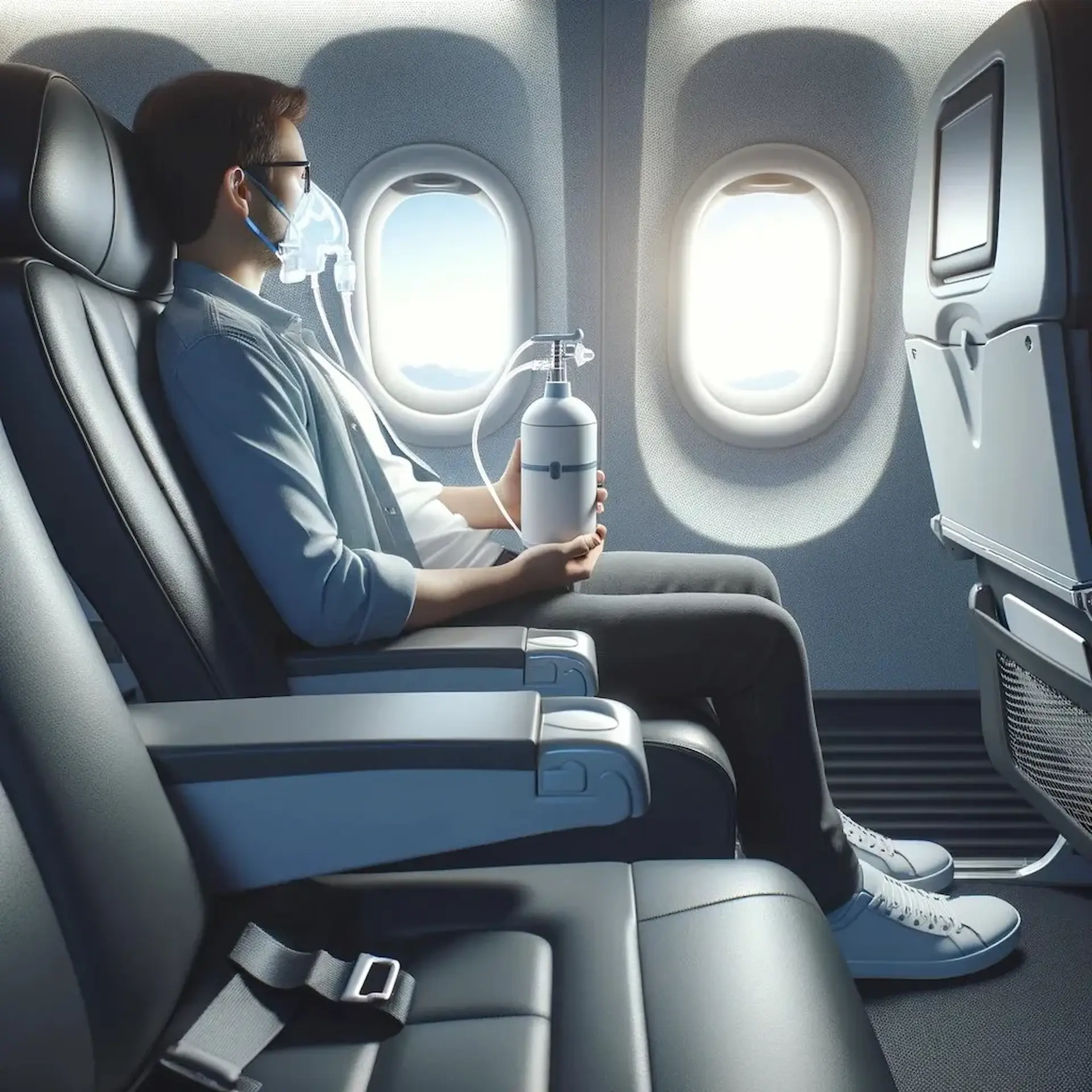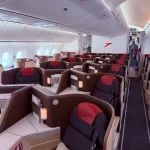Traveling with medical oxygen is one of those things most people don’t think about,until they have to. Over the years, I’ve helped several family members and readers navigate flights with oxygen support, and I’ve learned the hard truth: every airline handles it differently. If you’re planning air travel with a chronic respiratory condition, understanding which airlines provide inflight oxygen,and how they manage it,is absolutely critical.
In this guide, I’ll explain what inflight oxygen actually means, which airlines provide it, what regulations apply, and how to prepare properly. I’ve reviewed more than 25 airline policies and spoken to frequent travelers who require oxygen. This article combines deep research with real-world expertise.
What is Inflight Oxygen and When is it Needed?
Inflight oxygen refers to supplemental oxygen provided by or carried onto an aircraft to support a passenger with medical conditions during the flight.
Cabin pressure at cruising altitude is equivalent to 6,000–8,000 feet elevation. For healthy people, that’s no issue. But for individuals with conditions such as:
- Chronic Obstructive Pulmonary Disease (COPD)
- Pulmonary fibrosis
- Heart failure
- Recent pneumonia or severe asthma
Even a modest drop in oxygen saturation can lead to hypoxia, fatigue, or respiratory distress.
It’s important to distinguish emergency oxygen (available in all aircraft) from pre-arranged medical oxygen, which passengers must request in advance or bring as an approved device.
Do Airlines Provide Inflight Oxygen Upon Request?
Some airlines provide oxygen cylinders on request. Others require passengers to bring their own FAA- or EASA-approved Portable Oxygen Concentrators (POCs). The approach depends heavily on:
- Safety regulations (e.g. FAA in the U.S., EASA in the EU)
- Liability policies
- Aircraft configuration
- Length of flight
From personal experience and in reviewing dozens of policies, I’ve found that:
- U.S. carriers typically do not provide medical oxygen. You must bring your own POC.
- Many international carriers do provide medical oxygen, sometimes for free, sometimes at a fee.
- Budget airlines almost never offer it, but they often allow POCs with documentation.
It’s always the passenger’s responsibility to notify the airline in advance,usually 48 to 72 hours before departure.
Which Airlines Provide Inflight Oxygen?
Here is a list of major airlines that offer inflight oxygen upon request, along with their general policies:
| Airline | Medical Oxygen Provided? | Advance Notice Required | Fees/Restrictions |
| Lufthansa | Yes | 48–72 hours | Approx. 300 euro per flight |
| Air France | Yes | 48 hours | Limited to select routes |
| KLM | Yes | 48 hours | Must fill out MEDIF form |
| Japan Airlines | Yes | 72 hours | Requires medical clearance |
| ANA (All Nippon Airways) | Yes | 96 hours | Special application form |
| Turkish Airlines | Yes | 48 hours | Limited supply; fee may apply |
| Emirates | Yes | 48 hours | Free, but limited availability |
| Singapore Airlines | Yes | 48–72 hours | Chargeable; must request early |
| Qantas | Yes | 5+ days | Fees and equipment approval |
| Korean Air | Yes | 48 hours | Special arrangements needed |
Many other international carriers offer similar services, but they require medical documentation (e.g. MEDIF forms) and early booking. Policies vary by aircraft type and route.
Which Airlines Do Not Provide Medical Oxygen?
Most U.S.-based airlines no longer provide oxygen tanks onboard for passenger use due to FAA regulations.
| Airline | Medical Oxygen Provided? | Alternative |
| Delta Air Lines | No | FAA-approved POC only |
| United Airlines | No | FAA-approved POC only |
| American Airlines | No | FAA-approved POC only |
| Alaska Airlines | No | FAA-approved POC only |
| Southwest Airlines | No | FAA-approved POC only |
| JetBlue | No | FAA-approved POC only |
U.S. carriers follow strict DOT and FAA guidelines, and passengers must travel with their own battery-powered Portable Oxygen Concentrator.
What are the Rules for Personal Oxygen Concentrators (POCs)?
A POC is a medical device that delivers oxygen in concentrated form from ambient air. Most airlines allow certain FAA- or EASA-approved POC models. Flying with your own Portable Oxygen Concentrator is the most flexible and globally accepted option.
Here’s what you need to know:
- Only FAA-approved or EASA-compliant devices are allowed.
- Devices must be labeled accordingly (e.g. “RTCA DO-160”).
- You must carry batteries covering at least 150% of flight time, including layovers.
- Batteries must be non-spillable and stored in carry-on bags.
- Airlines can request a medical certificate or MEDIF form confirming need and safety for travel.
Some popular FAA-approved models include:
- Inogen One G5
- Philips SimplyGo Mini
- SeQual Eclipse 5
- AirSep Focus
If you’re flying long-haul, I strongly advise you to bring at least two fully charged batteries and check airline-specific watt-hour limits.
How to Request Inflight Oxygen from an Airline
General Steps
- Contact the airline’s medical desk at least 48–96 hours in advanc
- Submit MEDIF (Medical Information) form if required
- Confirm the availability of oxygen tanks or equipment onboard
- Check fees (some charge per segment)
- Ensure your seat assignment supports oxygen device use
- Get written confirmation from the airline
Tip:
Avoid booking third-party if you need oxygen support. Always book directly through the airline, so you can coordinate medical services efficiently.
What Are the Limitations of Inflight Oxygen Services?
Inflight oxygen comes with several constraints:
- Flow rate is fixed on many airlines,commonly 2 or 4 L/min.
- No high-flow options above 4 L/min are provided.
- Airlines often do not provide oxygen on the ground (e.g. during boarding or layovers).
- Oxygen may not be available on every aircraft in the fleet.
- Not all flights (especially short-haul) offer medical support staff.
For this reason, many patients prefer to travel with their own oxygen supply. It gives more control over timing, dosage, and comfort.
Is There a Fee for Inflight Oxygen?
Yes, on most carriers. Fees vary significantly:
- Lufthansa: Approx. 300 euro per long-haul segment
- Singapore Airlines: Based on liters per minute and flight time
- Emirates: Usually free but limited in availability
- ANA / JAL: Sometimes free, but subject to aircraft and route
U.S. airlines don’t charge for POCs, but they do not supply oxygen tanks at all.
How to Plan a Trip When You Need Inflight Oxygen
Here’s a proven step-by-step plan:
- Consult Your Doctor Early
Ask if you’re medically fit to fly and what oxygen rate you need. - Choose the Right Airline
Prioritize airlines that offer either medical oxygen or allow POCs. - Get Documentation Ready
Complete MEDIF forms and request a formal medical clearance. - Notify the Airline Immediately After Booking
Call the airline’s medical desk,not customer service,to flag your need. - Confirm Equipment Rules and Battery Limits
Ask about inflight power options and bring enough batteries. - Arrive Early at the Airport
Check in with extra time to avoid boarding complications. - Carry a Copy of All Documentation
This includes prescriptions, device certificates, and MEDIF approvals.
Who Should Fly with Medical Oxygen?
If your oxygen saturation at rest drops below 92%, you should consult your doctor about flying with oxygen. Conditions that commonly require it include:
- COPD with chronic hypoxemia
- Pulmonary hypertension
- Cystic fibrosis
- Advanced heart failure
- Recent hospitalization due to respiratory illness
A simple pre-flight oxygen assessment (hypoxia altitude simulation test) can determine your need. Elderly passengers and post-surgical patients may also need supplemental oxygen, especially on long-haul or high-altitude routes.
Which Airlines Are Best for Passengers Needing Oxygen?
Based on research and hands-on experience:
- Best Overall for Medical Oxygen: Emirates, Singapore Airlines, Lufthansa
- Best for POC Use Only: American Airlines, Delta, United
- Best for Free Oxygen Services: British Airways, Emirates, Singapore
- Most Transparent Policies: Lufthansa, Air Canada, Qatar Airways
When planning travel with oxygen, early preparation is everything. Understand the policies, get your documentation in order, and pick an airline that supports your medical needs without unnecessary stress.
Flying with oxygen is absolutely possible,I’ve done it alongside family members many times,but it requires the right airline and detailed planning.
FAQ: Inflight Oxygen for Passengers
Do U.S. airlines provide oxygen onboard?
No. U.S. airlines (Delta, United, American) do not offer medical oxygen tanks. You must use an FAA-approved POC.
How do I know if my POC is approved?
Check the FAA/EASA list and confirm with the airline. Bring documentation, including manufacturer label and battery certification.
Can I bring extra oxygen tanks?
No. Compressed oxygen tanks are not allowed in the cabin or checked baggage unless provided by the airline.
Can I use oxygen during takeoff and landing?
Yes, but your POC must be approved for all phases of flight. Some airlines ask that it be stowed under the seat, not held.
Is oxygen covered by travel insurance?
Not always. Check with your insurer. Some policies cover pre-flight medical clearances or device rentals but not onboard oxygen services.





